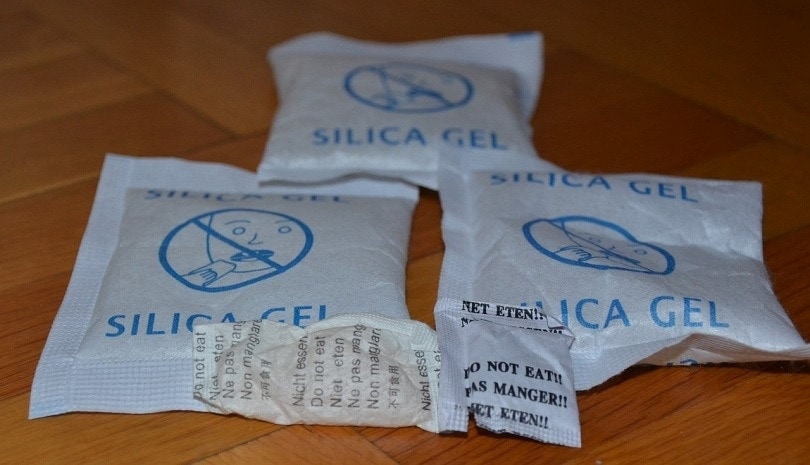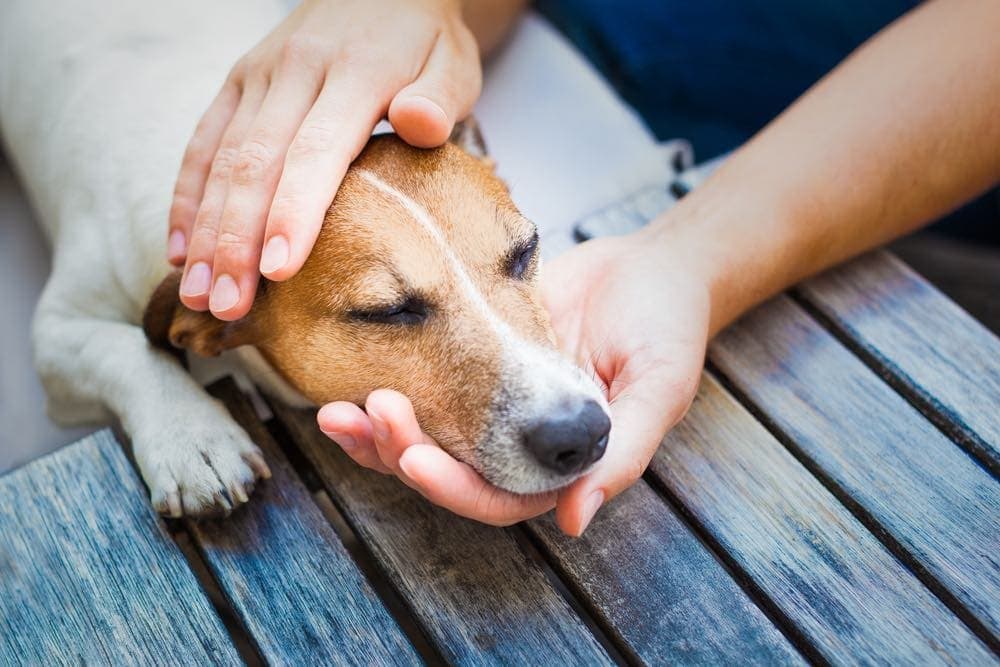Help! My Dog Ate Silica Gel
Silica gel most frequently appears in tiny packets — about 1″x1″ or slightly larger. Silica is a desiccant — it absorbs moisture to keep items from deteriorating. You’ll usually find the little crystal packages nestled in shoeboxes, bags, or included with electronics.
Canines will eat just about anything left lying around. If you leave a stray silica packet within the puppy’s reach, he may chew on it and make a snack out of the little pellets. Silica is something that can have some toxicity to dogs but doesn’t usually cause serious health problems.
Fortunately, if your dog is affected, the gel shouldn’t cause any long-term harm. If your beloved pet samples some silica, your best course of action is to keep an eye on her. If you notice any symptoms, you can contact your vet to find out what your next steps, if any, should be.
Ingesting the small amount contained within a shoebox or clothing pocket may not cause any problems at all. Your dog may have some digestive issues like stomach upset and possibly even vomiting and diarrhea. If you’re concerned about the symptoms, it’s not a bad idea to contact your veterinarian just to get a professional’s opinion on what to do. If you can’t reach your vet, you can call the Pet Poison Helpline.
If, however, your dog consumes a large amount of silica, there may be more cause for concern. While your dog may not require any treatment, it’s never a bad idea to consult someone with some expertise in this area. And making the call can give you peace of mind.
Why Has My Dog Eaten Silica Gel?
Dogs have a heightened sense of smell and many of them are very interested in their surroundings. This means that dogs will often gobble up the most bizarre items that may not always be edible, let alone safe for them. Silica gel is one of those items that may interest your dog and, believe it or not, it is a relatively common occurrence for dogs to eat silica gel.

Dogs may be interested in eating silica gel because it smells like the tasty thing it was packaged with—they’re often included in packs of treats to stop them from absorbing moisture and spoiling. Sometimes, there’s no known reason for a dog to eat silica gel—they just ate it! However, if your dog is regularly chewing or eating inedible items, we recommend having a check-up with your veterinarian to discuss the possibility of a medical or behavioral cause.
Some dogs may be more interested in eating inedible items than others—it will depend on their age and personality. Puppies that are teething or playful dogs are likely to seek out items to chew and may inadvertently ingest that item without realizing that it is harmful to them. It is advisable to research and understand what is or isn’t safe for our dogs and ensure that inedible and dangerous products are put out of reach of our beloved family pet.
Keep reading to find out everything that you need to know. We will look at whether silica gel is toxic to dogs, what to do if they ingest it, and how to prevent dogs from eating inedible items in the first place.
Little packets of silica gel are placed within many different products, such as food, clothing, and electrical items, as they help absorb water vapor, thus preventing products from getting damp and becoming damaged or soiled. The silica gel balls or beads contained within these little packets are essentially silicon dioxide, a porous form of sand.
What Happens If My Dog Has Eaten Silica Gel?
Depending on the size of your dog and the amount of silica gel they have eaten, it may be necessary for a veterinary visit for further assessment and treatment. This may include inducing vomiting, x-rays, or hospitalization for observation and treatment.
Alternatively, your veterinarian may suggest monitoring at home is all that is necessary. If your veterinarian would like you to monitor your dog, you should look for any signs that your dog is not feeling like his normal self. This may include signs of an upset stomach such as vomiting, nausea, drooling, and abdominal pain. Lethargy and diarrhea may also be seen. You may also notice silica gel packets being passed in your dog’s stool. You should contact your veterinarian with an update if your pet’s condition and symptoms are worsening, especially if you notice lethargy or that your dog cannot keep food or water down. If your dog is not passing feces or struggling to defecate it is advisable to contact your veterinarian urgently.

My Dog Ate Silica Gel | What To Do Now?
Whether in a bag of beef jerky or a bottle of vitamins, you have probably seen the little white moisture-absorbing packets filled with silica beads inside. On the outside of most packages, the label reads not to consume the contents. Luckily, if your pooch consumes them, those silica beads are unlikely to cause him trouble.
While these little packets of silica gel beads are labeled not for consumption, they are actually harmless if eaten. Their purpose is to absorb moisture, keeping the products theyre packaged with fresh. Because of their labeling, many people assume they are toxic. Silica gel bead ingestion is among the top 10 reasons for calls to the Pet Poison Helpline.
While silica beads are inert and nontoxic, your pup may experience mild gastrointestinal upset after ingestion. The main complication is the packet, not the beads. The packet can cause intestinal blockage, especially in smaller dogs. A package from inside a medicine bottles may have absorbed some medication, which may be toxic. If your dog ingests silica bead packets, monitor him for signs of intestinal obstruction. These include vomiting, diarrhea, lethargy and loss of appetite. Consult your veterinarian if any of these symptoms occur after ingestion.
Deborah Lundin is a professional writer with more than 20 years of experience in the medical field and as a small business owner. She studied medical science and sociology at Northern Illinois University. Her passions and interests include fitness, health, healthy eating, children and pets.